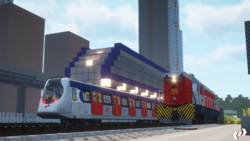Joestu Line
Views
Actions
Namespaces
Variants
Tools
| Status | Operational |
|---|---|
| Owner | Kowloon-Canton_Railway_Corporation |
| Locale | Joban, Kansai, Sendai |
| Termini | Central_South Maiko (As of Aug, 2024) |
| Stations | 48 (45 in operation) |
| Initials | JLP1, JLP2, JLP3 |
| Operator(s) | Kowloon-Canton_Railway_Corporation |
|---|---|
| Depot(s) | Fuka_Depot Kansai_Depot |
| Rolling stock | KCR EMU MLR SP1900 KCR_C-Train KCR_Locos |
| Former Rolling Stock | KCRC_K-Stock KCRC_M-Train |
| Opened | May 1st, 1872 |
|---|
| Line Length | 65km (40.4mil) |
|---|---|
| Track gauge | 1435mmm |
| Electrification | 2500Kv |
| Operating speed | 120km/h |
The Joestu Line (Chinese: 喬斯圖線) is a rail line operated by the Kowloon-Canton Railway, stretching from Central in the west to Maiko in the south (As of Aug, 2024), the line acts as the main transport link between Eastern and Western Joban.
The name "Joestu" comes from the original server Country of Joestu, but after migration to The District of Joban has still be kept by KCRC.
History
Before merger
The Joestu Line is an amalgamation of various different companies including the Kintetsu, Joestu Railway Company and the Kowloon-Canton Railway. Since history of all 3 companies hasn't been preserved due to World War One causing much damage to the Joestu Line, little is known about the early days of the Joestu Line.
After merger
On 16th of March, 1943, the Kowloon-Canton Railway would aquire the Kintetsu and Joestu Railway Company and would through run trains using the newly combinded fleet of C51s, C55s, C57s, these trains would run every hour running from Central up to Sendai in nearly 18 hours, with breaks taken at major terminals for refueling. This proved to be inefficient and a waste of time for passengers, and with compeiting coach services, KCR JS (Kowloon-Canton Railway Joestu Section) decided to aquire Diesel Locomotives from various different companies.
End of Steam and the era of Diesel-powered trains
The introduction of G12 Locomotives in 1951 proved to be a success after theethng problems were resolved, where journey times could be cut down to 15 hours and refueling times cut by half. So sucessful of the introduction of these locomotives that KCRC would decide
